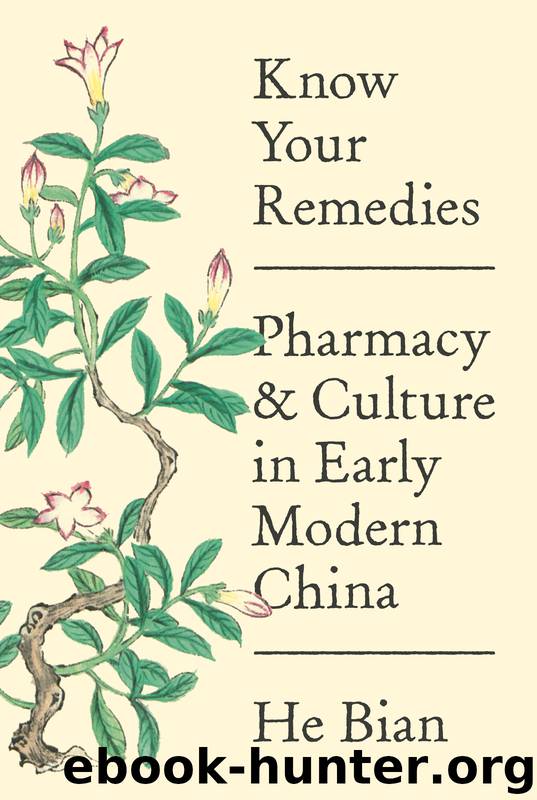Know Your Remedies by He Bian;

Author:He Bian;
Language: eng
Format: epub
Publisher: Princeton University Press
Published: 2020-03-05T16:00:00+00:00
Division of Labor in the Song-Ming Medical Marketplace
In Tang-Song times, physicians were essentially shop owners who compounded their own remedies. The Tang pharmacopeia preserved in full Tao Hongjing’s earlier instructions on pharmaceutical processing and instructed physicians on how to prepare an existing formula into dosage forms, such as pills, powders, ointments, and tinctures. Languishing in the Tang capital city Chang’an, the poet Zhang Ji (c. 766–830) complained about being overcharged by “physicians of the pharmacies” (yaopu yiren).6 In the designated neighborhoods of Chang’an where markets were held, physicians were perceived as liable to the greed and deception that killed virtue. In his exile, the banished official Liu Zongyuan (773–819) wrote an essay commemorating an extraordinary man named Song Qing, who traded in the west market of Chang’an and supplied raw medicine to artisanal physicians (yigong). Unlike other merchants, Song never pursued his debtors who were poor; in the end, he was repaid handsomely with their gratitude. At the end of this celebrated essay, Liu lamented the rarity of Song Qing’s virtue in an age where the “Way of the Marketplace” (shi dao) reigned supreme, even in officialdom.7
The medicinal marketplace in the Northern Song further diversified at a time when cities were no longer bound by strict rules separating residential and commercial quarters.8 At the height of its prosperity, the Northern Song capital Kaifeng boasted over a dozen medical shops (yipu) in various neighborhoods of the city. The Song government’s active promotion of medical learning gave official ranks to many elite physicians who opened shops proudly displaying their titles and specialties ranging from pediatrics to obstetrics. One such shop, “medical officer Zhao’s home” (Zhao taicheng jia) was depicted in Qingming shanghe tu (Along the River during the Qingming Festival), arguably the most celebrated scroll painting of urban life created at the Song court. The artist depicted the physician Zhao treating a young patient in his shop opening onto the busy street, with multiple signs on display advertising his compound medicines (see figure 5.1). Others devised eye-catching trademarks such as “Silver Baby,” “Dr. Du the Golden Hook,” “Dr. Ren the Big Shoe,” or “Ugly Granny’s Medical Shop.”9 The commercial nature of medicine was likewise proudly celebrated in documentations of the urban scene in the Southern Song capital Lin’an (later Hangzhou), where medical shops continued to boast official prestige (“Home of Defense General Ban”).10 One could imagine the bustling street scenes, in which practicing physicians’ shops were an commanding presence.
Historians usually cite an anecdote dated to the thirteenth century as the earliest evidence for the emergence of general pharmacies in China, where the manufacturing space of a workshop (zuofang) was melded with the retail shop. Upon closer scrutiny, however, the author, Zhou Mi (1232–98), was in fact describing peddlers selling “raw medicine cut in pieces for decoction” (shengyao yinpian) and “cooked medicine in pills and powders” (shuyao wansan), along with steamed buns, roasted meats, preserved candy jujubes, and kumquat tangerines. Zhou noted that businesses of Lin’an became so “proud and idle” that they
Download
This site does not store any files on its server. We only index and link to content provided by other sites. Please contact the content providers to delete copyright contents if any and email us, we'll remove relevant links or contents immediately.
The Poisoner's Handbook by Deborah Blum(1977)
Bottle of Lies by Katherine Eban(1703)
Mycelium Running: How Mushrooms Can Help Save the World by Paul Stamets(1575)
The Vaccine Race by Meredith Wadman(1560)
Missing Microbes by Martin Blaser(1518)
Pharmacy Practice and The Law by Richard Abood(1493)
The Doors of Perception and Heaven and Hell by Aldous Huxley & Aldous Huxley(1489)
Decisive by Chip Heath(1455)
Steroids: History, Science, and Issues by Standora Joan E.; Bogomolnik Alex; Slugocki Malgorzata(1426)
28 Seconds by Michael Bryant(1420)
The Doors of Perception: Heaven and Hell (thINKing Classics) by Aldous Huxley(1409)
McGraw-Hill Nurses Drug Handbook by Patricia Schull(1395)
Ganja Yoga by Dee Dussault(1383)
What's Making Our Children Sick? by Michelle Perro(1347)
Complete Guide to Prescription & Nonprescription Drugs 2014 by H. Winter Griffith(1280)
Stealing Fire: How Silicon Valley, the Navy SEALs, and Maverick Scientists Are Revolutionizing the Way We Live and Work by Steven Kotler & Jamie Wheal(1276)
Anatomy of an Epidemic by Robert Whitaker(1236)
Trip by Tao Lin(1233)
Cannabis for Chronic Pain by Rav Ivker(1162)
